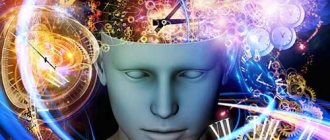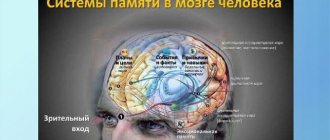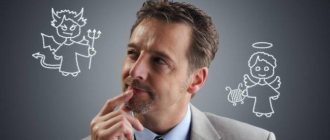A mental process such as imagination plays a special role in human life. It promotes not only creative activity, as many may think, but is also involved in solving more mundane and everyday issues, although the subject himself may not be aware of this. As the outstanding psychological theorist L.M. stated. Wecker, imagination is a cross-cutting process that is closely related to all other mental functions, such as memory, thinking and will. This point of view makes us understand that a developed imagination in general is a good assistant in any life situation.
The world of imagination: imagination in psychology
Imagination in psychology is understood as a complex mental process that creates new images of objects, situations and phenomena based on past perceptions. Simply put, imagination is the creation of something new from something old. Imagining what a long-destroyed ancient temple looks like based on its description, or inventing a non-existent animal with horns and wings, uses already known elements so that we understand what something that does not actually exist at the moment looks like.
Thinking and imagination
The specificity of the concept of imagination is that it is difficult to separate it from the same visual-figurative thinking (operating with images, rather than verbal units - words, syllables, phrases, calls, etc. - to solve a problem, without using objects from this task in real life). For a long time there was an idea that the imagination is capable of creating thoughts, which are essentially psychically formed connections between images and/or knowledge. But such an approach could not exist for long, because then thinking, as a mental process, would have no meaning. Scientists have come to the conclusion that the main distinguishing feature of the imagination will be the creation of new, previously unperceived images by humans. A.V. Brushlinsky, a Soviet and Russian psychologist, emphasizes the close relationship between thinking and imagination based on the fact that the imagination operates with the products of thinking (communications, inferences, analysis, synthesis and abstraction), and thinking itself is based on those sensory images that the imagination creates .
Types of imagination
Today in psychology the following types of imagination are distinguished:
- the reproductive creates an image, the elements of which are already known to man. For example, when describing a middle-aged literary character who has blue eyes and a mustache, we use several elements we already know (in this case, the face of a middle-aged man, blue eyes and a mustache). This also includes reproducing what the house will look like based on its drawing.
- productive imagination, which is also called creative , involves the creation of images that are unlike anything the subject has ever perceived. Already known elements are also used here, but, unlike the reproductive type, the creative imagination creates something that, in fact, does not exist in reality. For example, we have two elements - lilac and wild fox. By combining them, we create something that, in our opinion, does not exist in reality, namely, a lilac fox.
- Passive imagination is that imagination that acts without our volitional efforts. An example here is a dream or hallucination.
- active imagination, accordingly, is necessarily accompanied by our intention to imagine or invent something.
- concrete imagination is based on a visual representation of objects.
- abstract imagination operates with generalized images, namely symbols (verbal and non-verbal), diagrams and ideas.
- plastic imagination, which L.S. Vygotsky, known for his cultural-historical concept, describes as something that borrows its elements from the outside (can be called objective).
- vague – the one that operates with more emotional images (can be called subjective).
There is also a categorization of imagination based on the scope of its application. For example, the French psychologist and teacher of the late 19th century Theodule Ribot gives the following types:
- mystical, which uses symbols,
- scientific, which is more rational,
- practical and mechanical, the images of which can turn into speech (verbal) form,
- in the field of trading, often based on intuition,
- in the sphere of utopia, where it is a mirror for social and ethical relations.
Mechanisms of imagination
At the moment, the following mechanisms of imagination are known in psychology, allowing it to perform its functions:
- Hyperbolization is an exaggeration of the qualitative or quantitative properties of an object (a huge problem, a billion mosquitoes, etc.).
- Litotes is an understatement, the reverse mechanism of hyperbolization.
- Sharpening or accentuation - emphasizing individual features (an example would be caricatures where a chatterbox has a long tongue, and a liar has a nose).
- Agglutination ( combination ) - the combination of two elements (a green cloud, a dog the size of an elephant, a book with wings, etc.)
- Schematization - ordering, generalization of elements into a clear structure (ornaments, paintings).
- Typification is highlighting something common in several images and assigning them to a separate group (doctors, representatives of the cat family, fiction books, etc.).
The Meaning of Imagination
The importance of imagination is reflected in any life situation, and some of its functions are unique to humans, which makes our stage of development of imagination in phylogeny one of the distinctive features of humans as a species. Imagination has become an important asset of the human psyche due to its following functions:
- Regulation of an individual's emotional states . For example, imagination can play a compensatory role, helping a person avoid frustration - a state caused by a discrepancy between what is desired and the ability to achieve it. A classic example of the study of this particular function of the imagination is the theories of psychoanalysis.
- Regulation of human physiological states . Research has shown that the process of imagination can cause activity in quite a few areas of the brain, including the hypothalamic-limbic system. Therefore, it is quite logical to draw a conclusion about the influence of this process on our body. A striking example is that on every anniversary of St. Bartholomew's Night, the famous philosopher Voltaire's temperature rose at the sole thought of the thousands of murdered Huguenots in 1572.
- Solving problems based on operating with images. When solving problems with a sufficient amount of known data, we use thinking, but when this data is too little, and we need to go beyond the usual system for solving a problem, we use imagination. Thus we can say that thinking creates theories, and imagination creates hypotheses.
- Anticipation . In order to come up with a plan of action that we want to carry out in the future, we need to use our imagination. After all, as mentioned earlier, to solve a problem with many unknowns, which is our future, we use not so much thinking as imagination. In order to be confident in your plan, you must first play it out in your head. We can say that our memory is a look into the past, thinking into the present, and imagination into the future.
- Planning and programming of activities . Having built and played out a plan of action in our head, we also tune in to this activity with the help of our imagination. This process is a symbiosis of the functions of anticipation (prediction) and regulation. A.R. Luria, one of the founders of neuropsychology, described the situation that happened to Solomon Shershevsky, known for his phenomenal memory, when he was preparing to speak in court. He imagined the trial in his head, imagining that the judge was on the right. But when Shershevsky arrived in court, the judge was sitting to his left, because of which all his logic disappeared, he was confused, and the case was lost.
In addition to its functions as a mental process, imagination also plays its role as the cause of a person’s individual characteristics. How and how much a person used his imagination influences the manifestation of creative activity, will, inclination and desire for a specific type of activity. Within the framework of his socio-historical concept, Vygotsky devotes an entire book to the problem of the role of imagination in the formation of an individual’s personal characteristics - “Imagination and Creativity in Childhood.”
Fantasy and imagination
Some authors consider fantasy and imagination as synonymous concepts, but they should be separated. At its core, fantasy is a product of the imagination, the distinctive feature of which can be called its unrealization. It is designed to perform a compensatory function to regulate emotional states; can be active or passive, mainly considered as a reproductive process. When fantasizing, we are not aimed at realizing the content of our fantasies, which are intimate for us, and their source is in our unconscious. However, fantasies can push us to actions that will use our already productive imagination. This chain is the basis for many works of art and scientific discoveries.
History of discovery and study
In Russian psychology, interest in the phenomenon arose along with the study of other functions of the psyche. The main contribution to the study process was made by L. Vygotsky. He dedicated a book and dozens of articles to the imagination - a fundamental presentation of findings and theories regarding the development of the ability to imagine in ontogenesis.
Vygotsky paid great attention to the development of cognitive processes in preschool age. The scientist believed that this period was critical
He considered the ability to imagine in preschool age as the ability to create a whole from elements.
Vygotsky noted the complexity of mental activity and gradual development. According to his theory, creative activity depends on acquired experience. The child expresses accumulated knowledge through creativity. The accumulation process is influenced by various factors: interests, needs, desires. The ability to express oneself in childhood and adulthood depends on the speed of their satisfaction. Negative experiences acquired in childhood affect the adult individual.
Development of imagination
As has already been shown, imagination is an important component of mental activity. Its development promotes personal growth. Therefore, it is not surprising that many want to improve its performance. The famous director Konstantin Stanislavsky, when developing his acting system, paid attention to ways to develop imagination.
- Expanding your horizons and knowledge base . As follows from the definition of imagination, for its greater diversity it is necessary to replenish your library of images and knowledge so that you can create more original and complex images of the imagination.
- Ability to present a subject clearly . The more clearly we imagine an object, the more detailed we can use its characteristics.
- Purposeful Imagination . By being able to control the flow of images created by the imagination, we thereby subjugate it to ourselves. This way, in a problematic situation, we can use our imagination faster and easier.
- Constant use of imagination . Don't be lazy and automatically do things where you can use your creativity. The more often we use some mental function, the more attention we pay to it, the more developed and flexible it becomes.
By developing our imagination, it doesn’t just become easier for us to solve creative problems. Our imagination, closely interconnected with all mental processes, is an important component that helps to find a way out of any difficult situation.
We constantly detect plagiarism on our materials without providing a clickable follow link to them.
In this case, without warning, we turn to Google DMCA , which leads to pessimization of the plagiarist. On the contrary, we welcome the popularization of our materials, but with the obligatory active follow link to this page psyhosoma.com/voobrazhenie-i-ego-rol-v-zhizni-cheloveka/ .
Main types
There are many examples in history when fantasies were later reflected in reality. Science fiction writers and inventors actively studied the world around us and were able to predict the development of humanity.
For example, computers, video calls, and space flights are found in the works of writers of the 20th century. In the 21st century, all this has become everyday things.
Children's imagination manifests itself most clearly during games.
Therefore, fantasy has its own functions; it cannot be considered a useless process. Psychologists don't know exactly why some people exhibit this ability more than others. There are several types of imagination.
Active
It was with his help that the entire culture was created. Active fantasy serves as motivation for a person, since he clearly imagines the result of his productive activity. With the help of certain actions, the image of the future is brought closer.
For example, a sculpture conceived a statue. He takes an ordinary piece of stone and begins to chip away at it little by little. The result is a specific figure.
In this type of imagination, a person is guided by his idea of an object that does not exist in nature. Therefore, such fantasies made it possible to create all objects of art.
Passive
This species is characterized by dreams and fantasies. A person only invents different images, but is in no hurry to translate them into reality. This process is not dangerous, but some people devote all their time to it and give up on real work.
Dreams themselves help to distract from problems
A person himself evokes images, indulges in daydreams and imagines what and how he will change. A simple example of passive imagination is Oblomov from Goncharov’s novel. He lay on the sofa, dreaming about how he would get married and improve the estate. But even for the sake of the woman he loved, he did not dare to change anything, and remained with his dreams.
Alternative
There is another classification of fantasies. She distinguishes between voluntary and involuntary imagination. What characterizes voluntary imagination is its appearance when solving specific problems. For example, when doing math tasks, you need to visualize the solution
This is especially important for doing geometry exercises.
In dreams and random visions, this is where voluntary imagination is usually found. This happens especially often during meditation or other trance practices.
There is another classification that distinguishes reproductive and productive imagination. The first is characterized by the creation of images that are as close as possible to real objects. For the second, the material is processed as much as possible in the author’s thoughts, and then implemented in life. Different classifications allow you to look at the same term differently.
Essence and mechanism of action
Imagination is closely related to memory, attention, and thinking. Formed as a result of the emergence of social consciousness, to which a person turns in a problematic situation
Ability refers to cognitive processes that reflect objective reality. The basis of reflection is images of perception, memory, and representation.
If thinking explores the world in a general way, imagination allows you to create specific forms. The performance creates full-fledged pictures, based on reality or generated by fantasy. An individual invents without having any initial data, imagines phenomena that he has never seen. Intelligence is associated with imagination. The higher the level of intelligence, the more active the work of mental processes.
The essence of imagination is to create new images based on existing ones. The intensity and completeness of the result depends on experience and knowledge. Imagination arises in the process of work when the need to predict actions arises. By imagining images, an individual goes beyond reality, anticipates the result of work, and revives memories.
Functions and role
Tasks:
- Conveying reality through fantasy. Representation helps to reproduce seen phenomena and objects, remember them, and use them to transform reality.
- Regulation of behavior. When faced with a problematic situation, an individual can predict a program of action. Having selected a scenario, it adjusts the behavior according to the desired outcome.
- Managing emotions. In an excited emotional state, a person can use his imagination to relieve tension by imagining calming images.
The inability to plan causes frustration: the individual cannot start work, postponing until later. People with undeveloped imagination cannot concentrate even on urgent matters. They themselves don’t understand what’s stopping them.











